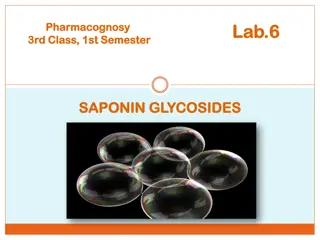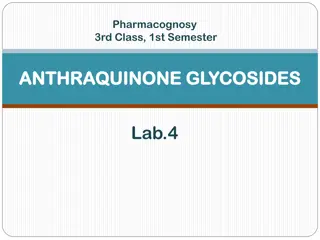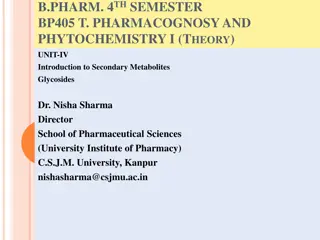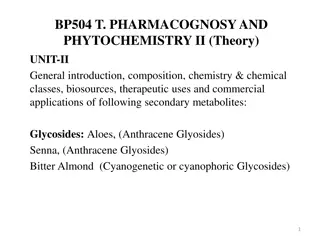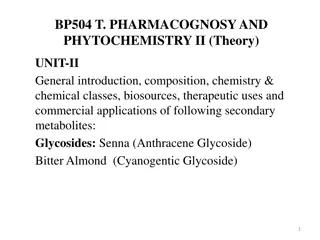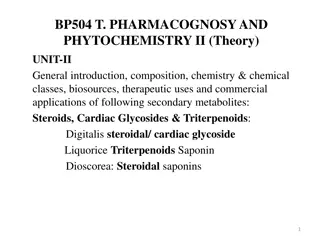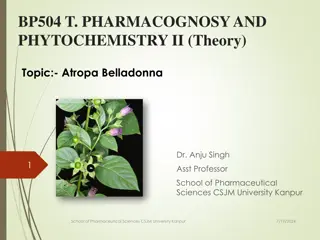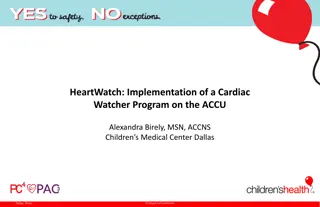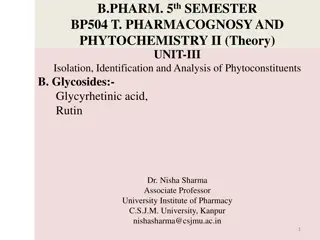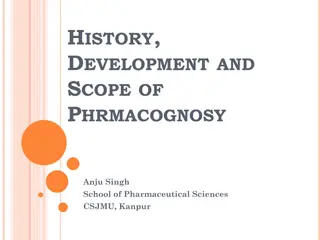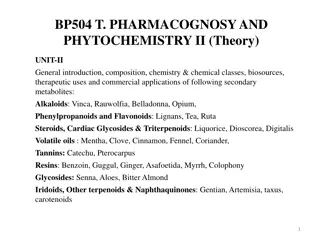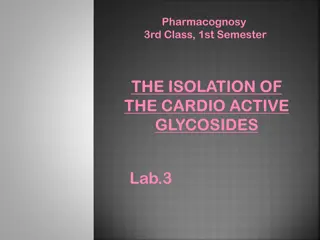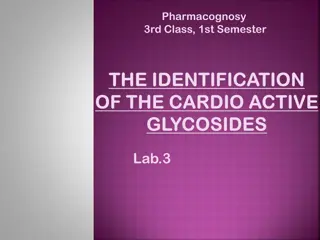Understanding Cardiac Glycosides in Pharmacognosy and Phytochemistry
Explore the role of Steroids, Cardiac Glycosides, and Triterpenoids in pharmacognosy and phytochemistry, focusing on their general introduction, composition, chemistry, biosources, therapeutic uses, and commercial applications. Learn about the structure and attachment of sugar parts in Cardiac Glycosides, the importance of specific positions for cardiac activity, and the diverse plant families containing these compounds.
Download Presentation

Please find below an Image/Link to download the presentation.
The content on the website is provided AS IS for your information and personal use only. It may not be sold, licensed, or shared on other websites without obtaining consent from the author. Download presentation by click this link. If you encounter any issues during the download, it is possible that the publisher has removed the file from their server.
E N D
Presentation Transcript
BP504 T. PHARMACOGNOSY AND PHYTOCHEMISTRY II (Theory) UNIT-II General introduction, composition, chemistry & chemical classes, biosources, therapeutic uses and commercial applications of following secondary metabolites: Steroids, Cardiac Glycosides & Triterpenoids: Liquorice, Dioscorea Digitalis 1
Steroids, Cardiac Glycosides & Triterpenoids O O O O CH3 CH3 CH3 CH3 Cardenolide Bufadenolide 2
Cardiac Glycosides General introduction: Aglycone part of cardiac glycosides is a steroidal moiety They are either C23 or C24 steroids as 5 member or 6 member lactone ring is present 5 member lactone ring- cardenolides- contain only 1 double bond, & attached at C-17 position of steroidal moiety 6 member lactone ring- Bufadenolides- contains 2 double bonds, & attached at C-17 position of steroidal moiety Bufadenolide- bufalin- obtained from skin of toads Sugar part is attached through- C-3, - linkage For the cardiac activity the attachment at specific position is important 3
Cardiac Glycosides The sugar part is attached via C-3 linkage Sugars reported to be present are: glucose, fucose, rhamnose, digitoxose, digitalose, cymarose, sarmentose, thevatose etc. Sugars- potentiates the solubilization of aglycone portion hence important for absorption & distribution in the body. Upto 3 sugars can be attached in a aglycone at a time se in no. of OH grps on aglycone leads to quick onset of action, enhances the metabolism 4
Cardiac Glycosides The sugar part is attached via C-3 linkage Sugars reported to be present are: glucose, fucose, rhamnose, digitoxose, digitalose, cymarose, sarmentose, thevatose etc. Sugars- potentiates the solubilization of aglycone portion hence important for absorption & distribution in the body. Upto 3 sugars can be attached in a aglycone at a time se in no. of OH grps on aglycone leads to quick onset of action, enhances the metabolism 5
Cardiac Glycosides Plants containing cardenolides: restricted broadly to angiosperms, leguminosae, sterculiaceae, cruciferae, scrophulariaceae, euphorbiaceae etc. Few families- Liliaceae & ranunculaceae contains bufadenolide 6
Digitalis Digitalis leaves, foxglove leaves Dried leaves of digitalis purpurea, fam. Scrophulariaceae, dried at temp below 60 C just after collection of leaves Not containing > than 5% of moisture GS: England, US, India The plant has been known in 10th century In 1542, Fuchs, named plant the digitalis In England the drug became official in 1650 In France- 1732, In Germany- 1771 In 1748 included in Russian pharmacopoeia In 1748- French scientist Salarve criticised the use of digitalis & the drug was withdrawn In 1785 onwards, after extensive research by William withering the drug received its importance again 7
Digitalis In India cultivated in Kashmir & nilgiri hills 100 seeds weigh 40-70mg 2.5 kg seeds req./ hectare of land, propogated In first year- rosette of leaves, in 2nd yr sessile leaves Leaves are picked in 1st and 2nd yr in afternoon when 2/3rd of flowers are fully developed After plucking, leaves are dried immediately in vacuum driers Packed into suitable air tight containers with dehydrating agent 8
Digitalis The activity of leaves is due to glycoside Presence of moisture and enzymes (digipurpuridase & oxidase) results into degradation of glycosides If leaves dried above 60 C, it results into loss of potency of drug due to chemical degradation thermally 9



